Mangoes and litchis taking a hit from the heat
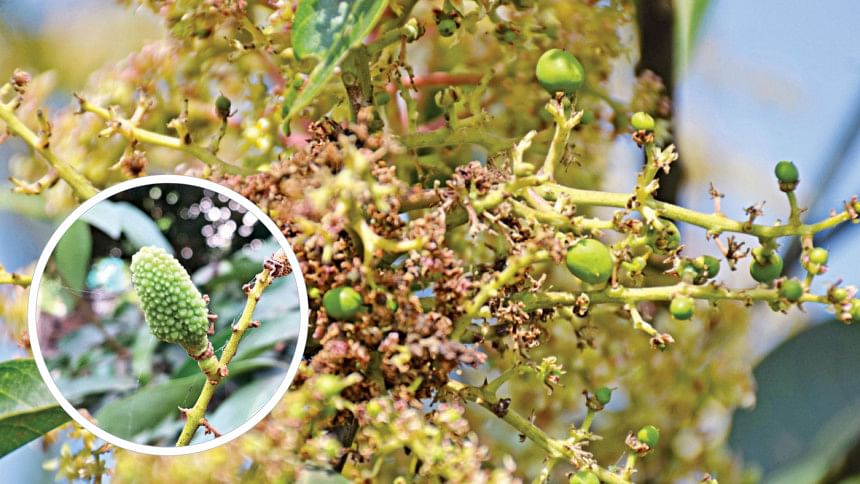
It's painful for Tajul Islam to see what has happened to his beloved mango orchard in Rajshahi city's Borobongram Namopara.
Amid the ongoing heatwave and absence of rain, almost half of his 25 mango trees have shed their flower buds before they could become mature fruits.
To make matters worse, this year's blossoms are already around 30 percent less than usual.
"This year has been like no other," Islam laments.
"Most of my mango trees didn't even flower due to the unfavourable weather with heavy fog, rain, and hailstorms stretching into the month of Chaitra. Now, in Baishakh, most of the surviving mango buds, my only hope, have fallen off."
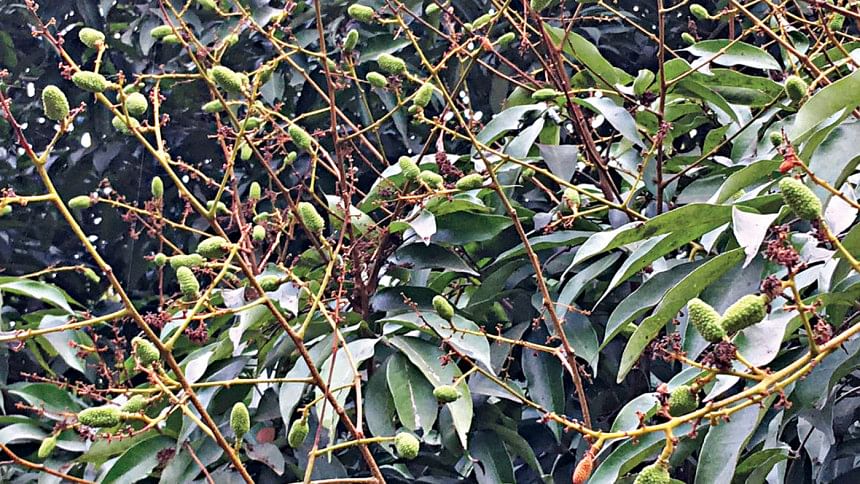
Like Tajul, many of Rajshahi's mango farmers are facing a potential disaster as bad weather, including drought, has gripped the region.
The heatwave and the absence of April rain have resulted in the blossoms drying up and falling off, raising concerns about a major drop in production this season.
While officials at the Department of Agricultural Extension (DAE) have acknowledged the challenges posed by the drought, they have also assured farmers that a complete disaster is unlikely.
Available reports indicate 30 percent of all mango buds have fallen off in many orchards across four districts of Natore, Naogaon, Rajshahi, and Chapainawabganj, said Mahmudul Faruque, additional director of regional DAE.
The DAE expects an aggregate yield of 12,19,910 tonnes of mangoes this year from 93,224 hectares of land in the four districts that account for half of the country's total mango production, he adds.
Last year, the region produced 12,07,263 tonnes of mangoes.
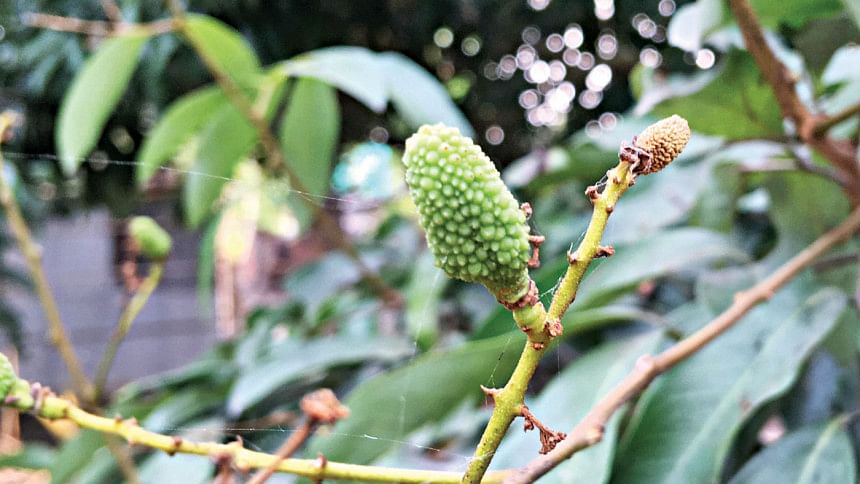
As things stand, the DAE is now suggesting the use of the flood irrigation method to save the fruits from drought.
"Moderate irrigation will not work this time. Growers need to keep their mango orchard under constant irrigation," says the DAE official.
Another farmer, Rabiul Islam, has cultivated mangoes on 22 acres of land in Kansat of Shibganj upazila in Chapainawabganj. He says he gets a yield of 88 tonnes of mangoes a year on average.
"The winter that was prolonged till early March did most of the damage. I'm fearing a 30 to 40 percent fall in production this year," Islam says.
Shafiqul Islam Sana, another grower, says his mango orchard on 300 bigha in Rajshahi's Bagha upazila has seen 50 percent less flowering.
"On top of that, another 30 percent of mango buds fell off due to the absence of rain. I'm having to irrigate my orchard more than I did before to save the surviving fruits."
Another grower, Anwar Hossain Polash of Arpara village in Bagha upazila, said he had hoped for a bountiful harvest this year, as farmers usually see a bumper yield every other year. Last year, his mango orchard on 60 bigha land saw a 50 percent drop in production.
"I harvested 4,000 maunds of mangoes last year, but this year's production will barely cross last year's amount," he says.
Meanwhile, litchi, another much-coveted summer fruit, is also being affected by the unforgiving weather.
Just a month ago, the trees in farmer Mirazul Sheikh's orchard in Shahapur village of Pabna's Ishwardi upazila were full of litchi buds and he was confident that this year would bring him the highest-ever yield.
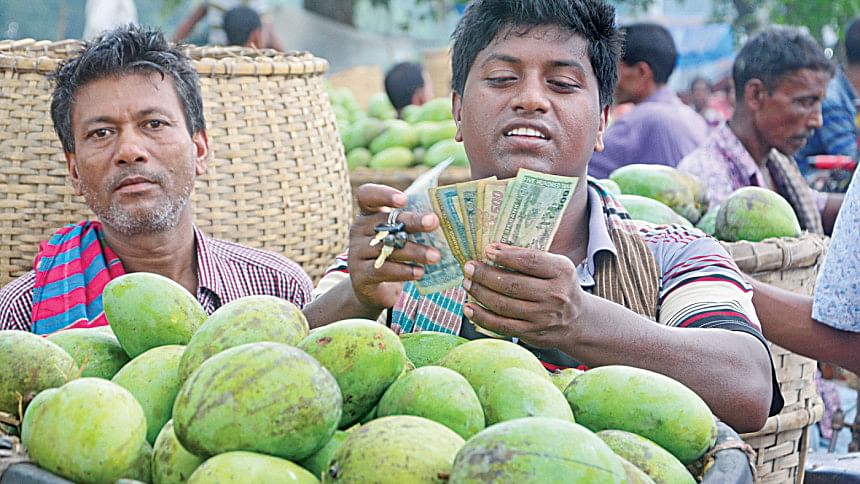
But his hopes were dashed as half of the buds were damaged due to the sudden torrential rain last month.
Mirazul had bought 500 saplings at Tk 5,000 to 8,000 each and was thrilled to see them in full blossom.
"I was expecting 12,000 to 15,000 litchis from each tree when the trees were in full bloom. Now, as most of the buds have been damaged, I may get 5,000 to 8,000 litchis from each tree."
Rakib Hossain, another litchi farmer from the same village, has a similar experience. Rakib blames the prolonged heat wave for the unexpected drop in yield. If this continues, he says, it will spell disaster for him.
However, Pabna DAE Deputy Director Dr Jamal Uddin says this level of loss of buds is natural and as such the agriculture department does not think farmers should worry too much.
"All buds don't turn into fruits and a certain portion of buds naturally are lost."
According to Pabna DAE, the 4,721 hectares of land brought under litchi cultivation in the district this year are expected to produce 48,801 tonnes of the summer fruit.
Of the total land under litchi cultivation, 3,150 hectares are in Ishwardi upazila.
"We are expecting a bumper litchi production this year as there is plenty of buds in litchi trees in the district," the DAE official says confidently.
"It's true, litchi trees have been affected during the hot spell, so we have suggested farmers that they should provide sufficient water to trees to combat drought in litchi fields. We also expect rain soon."
Some farmers are more aware of how to save their fruits from the elements. Unlike many other farmers, Naogaon's prominent mango grower, Sohel Rana, is less worried about the effect of the weather on his mangoes.
"I have learned how to take care of my mango orchards," he says, adding that the growers need proper training on how to protect their crops from forecasted bad weather.
"You can't expect all the fruits that appear in a tree to last; some are bound to fall off."
Retired fruit scientist Dr Alim Uddin agrees.
"Out of seven to eight fruits on a branch, only one or two survive," he said, adding, "Mangoes are known as the fruits of bad climatic conditions."
Dr Alim points out the bright side of this year's lower yield.
"The size and taste of mangoes is going to be the best this season, as the trees will bear fewer fruits."


 For all latest news, follow The Daily Star's Google News channel.
For all latest news, follow The Daily Star's Google News channel. 








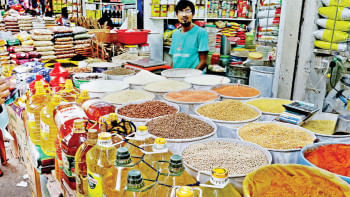
Comments